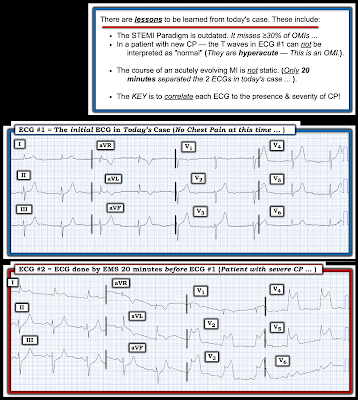======================================
CLICK HERE — for a Video presentation of this case! (18:00 min.)
- Below are slides used in my video presentation.
- For full discussion of this case — See ECG Blog #392 —
======================================
The ECG in Figure-1 was obtained from a man in his 60s — who described the sudden onset of "chest tightness" that began 20 minutes earlier, but who now (at the time this ECG was recorded) — was no longer having symptoms.
- In view of this history — How would YOU interpret this ECG?
- Should the cath lab be activated?
Figure-1: The initial ECG in today's case. (To improve visualization — I've digitized the original ECG using PMcardio).
Related ECG Blog Posts to Today’s Case:
- ECG Blog #205 — Reviews my Systematic Approach to 12-lead ECG Interpretation.
- ECG Blog #185 — Reviews the Ps, Qs, 3R Approach to Rhythm Interpretation.
- mmm
- ECG Blog #193 — Reviews the concept of why the term “OMI” ( = Occlusion-based MI) should replace the more familiar term STEMI — and — reviews the basics on how to predict the "culprit" artery.
- ECG Blog #194 — Reviews how to tell IF the “culprit” (ie, acutely occluded) artery has reperfused using clinical and ECG data.
- ECG Blog #294 — How to tell IF the "culprit" artery has reperfused.
- ECG Blog #183 — Reviews the concept of deWinter T-Waves (with reproduction of the illustrative Figure from the original deWinter NEM manuscript).
- ECG Blog #318 — ECG Blog #340 — and ECG Blog #341 — More on deWinter and deWinter-like T waves.
- ECG Blog #218 — Reviews HOW to define a T wave as being Hyperacute?
- ECG Blog #260 — ECG Blog #222 — and ECG Blog #292 — Reviews when a T wave is hyperacute — and the concept of "dynamic" ST-T wave changes.
- ECG Blog #387 — Dynamic change in 2 minutes.
- ECG Blog #230 — How to compare serial ECGs.
- ECG Blog #115 — Shows an example of how drastically the ECG may change in as little as 8 minutes.
- ECG Blog #337 — an OMI misdiagnosed as an NSTEMI ...
- ECG Blog #184 — illustrates the "magical" mirror-image opposite relationship with acute ischemia between lead III and lead aVL (featured in Audio Pearl #2 in this blog post).
- ECG Blog #167 — another case of the "magical" mirror-image opposite relationship between lead III and lead aVL that confirmed acute OMI.
- ECG Blog #271 — Reviews determination of the ST segment baseline (with discussion of the entity of diffuse Subendocardial Ischemia).
- ECG Blog #258 — How to "Date" an Infarction based on the initial ECG.
- The importance of the new OMI (vs the old STEMI) Paradigm — See My Comment in the July 31, 2020 post in Dr. Smith's ECG Blog.
- For review on when despite acute OMI — the initial hs-troponin may come back normal — See the March 24, 2023 post in Dr. Smith’s ECG Blog.
- The January 9, 2019 post in Dr. Smith's ECG Blog (Please scroll down to the bottom of the page to see My Comment). This case is remarkable for the dynamic ST-T wave changes that are seen. It's helpful to appreciate: i) That acute ischemia/infarction is not the only potential cause of such changes (cardiac cath was normal); ii) That changes in heart rate, frontal plane axis and/or patient positioning can not always explain such changes; and, iii) That entities such as repolariztion variants, LVH and/or acute myopericarditis may all contribute on occasion to produce an evolution of challenging dynamic ST-T wave changes on serial ECGs.
- The August 22, 2020 post in Dr. Smith's ECG Blog — which illustrates another case of dynamic ST-T wave changes that resulted from a repolarization variant.
- The July 31, 2018 post in Dr. Smith's ECG Blog (Please scroll down to the bottom of the page to see My Comment). This case provides an excellent example of dynamic ST-T wave changes on serial tracings in a patient with an ongoing acutely evolving infarction.
=======================
ADDENDUM: Some additional material on ECG diagnosis of OMI.
=======================
==================================
- I've added several Audio Pearls below with material relevant to today's case.
Today’s ECG Media PEARL #1 (3:00 minutes Audio) — Reviews the concept of deWinter T waves (and the common occurrence of variations on this "theme" ).
ECG Media PEARL #35a (4:50 minutes Audio) — WHEN is a T Wave Hyperacute vs a Repolarization variant?
ECG Media PEARL #39a (4:50 minutes Audio) — Reviews the concept of Dynamic ST-T Wave Changes (and how this ECG finding can assist in determining if acute cardiac cath is indicated).
ECG Media PEARL #46a (6:35 minutes Audio) — Reviews HOW to compare Serial ECGs (ie, Are you comparing "Apples with Apples" — or — with Oranges?).
ECG Media PEARL #10 (10 minutes Audio) — reviews the concept of why the term “OMI” ( = Occlusion-based MI) should replace the more familiar term STEMI — and — reviews the basics on how to predict the "culprit" artery.
ECG Media PEARL #11 (6 minutes Audio) — Reviews how to tell IF the “culprit” (ie, acutely occluded) artery has reperfused, using clinical and ECG criteria.

-USE.png)

-USE.png)







-USE.png)
-USE.png)
-USE.png)
-USE.png)






-USE.png)






No comments:
Post a Comment